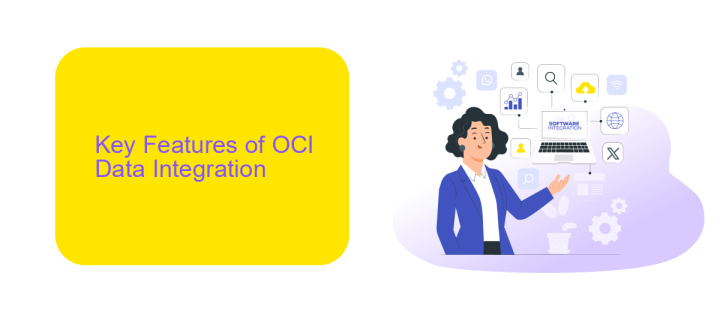OCI Data Integration
Oracle Cloud Infrastructure (OCI) Data Integration is a robust, cloud-native service designed to streamline data movement and transformation. It offers a seamless, intuitive interface for building, scheduling, and monitoring data workflows. With OCI Data Integration, organizations can efficiently manage complex data integration tasks, ensuring data accuracy and consistency across various sources and destinations in the cloud.
Introduction to OCI Data Integration
OCI Data Integration is a comprehensive, cloud-native service designed to simplify and streamline the process of data integration. It offers a robust platform for extracting, transforming, and loading data from various sources, ensuring seamless data flow across different systems and applications. This service is particularly beneficial for organizations looking to enhance their data management capabilities and improve operational efficiency.
- Automated data extraction and transformation
- Support for multiple data sources and destinations
- Real-time data processing and analytics
- Scalable and secure cloud infrastructure
By leveraging OCI Data Integration, businesses can achieve faster and more reliable data integration processes. Additionally, tools like ApiX-Drive can complement OCI Data Integration by offering easy-to-use interfaces and pre-built connectors for various applications, further simplifying the integration setup. This combination ensures that organizations can focus on deriving insights from their data rather than getting bogged down by technical complexities.
Key Features of OCI Data Integration

OCI Data Integration offers a comprehensive suite of tools designed to streamline and enhance data integration processes. One of its key features is the intuitive visual interface that allows users to design data flows without writing complex code. This drag-and-drop functionality simplifies the creation of data pipelines, making it accessible even for users with minimal technical expertise. Additionally, OCI Data Integration supports a wide range of data sources, ensuring seamless connectivity and data movement across various platforms.
Another standout feature is its robust data transformation capabilities, which enable users to cleanse, enrich, and transform data efficiently. The platform also includes advanced scheduling and monitoring tools, ensuring that data workflows run smoothly and on time. For those looking to integrate various APIs and services, tools like ApiX-Drive can be particularly useful. ApiX-Drive facilitates the connection between different applications and services, automating data transfers and reducing manual effort. Together, these features make OCI Data Integration a powerful solution for modern data integration needs.
Benefits of Using OCI Data Integration

OCI Data Integration offers a robust platform for managing and orchestrating data flows, making it an essential tool for businesses aiming to streamline their data processes. By utilizing this service, organizations can ensure data consistency, reliability, and efficiency across various applications and databases.
- Scalability: Easily scale your data integration processes to handle increasing data volumes without compromising performance.
- Cost Efficiency: Reduce operational costs by automating data workflows and minimizing manual intervention.
- Security: Ensure data integrity and compliance with advanced security features and encryption methods.
- Flexibility: Seamlessly integrate with various data sources, both on-premises and in the cloud, to create a unified data ecosystem.
- Real-Time Processing: Enable real-time data integration and analytics to make timely, data-driven decisions.
For those looking to simplify the setup of their integrations, services like ApiX-Drive offer additional support by providing user-friendly interfaces and automation tools. This enables even non-technical users to configure and manage complex data workflows with ease. Combining OCI Data Integration with ApiX-Drive can significantly enhance your data management capabilities, ensuring a more agile and responsive data infrastructure.
Use Cases for OCI Data Integration

OCI Data Integration offers a robust platform for automating and streamlining data workflows. This service enables organizations to efficiently manage, transform, and integrate data from multiple sources, ensuring data consistency and quality.
One of the primary use cases for OCI Data Integration is data migration. Companies can seamlessly transfer data from on-premises databases to the cloud, reducing downtime and ensuring business continuity. Additionally, it supports real-time data synchronization, which is crucial for maintaining up-to-date information across various systems.
- Data Migration: Seamlessly transfer data between on-premises and cloud environments.
- Real-Time Data Synchronization: Keep data consistent across multiple platforms in real-time.
- ETL Processes: Extract, transform, and load data efficiently for analytics and reporting.
- Data Quality Management: Ensure high-quality data through validation and cleansing processes.
- Integration with Third-Party Services: Utilize tools like ApiX-Drive to automate and enhance data integration workflows.
By leveraging OCI Data Integration, organizations can optimize their data management strategies, ensuring that data is accurate, accessible, and actionable. The integration capabilities, including those with third-party services like ApiX-Drive, provide a comprehensive solution for modern data challenges.


Getting Started with OCI Data Integration
To get started with OCI Data Integration, first, log in to your Oracle Cloud account and navigate to the Data Integration service. Create a new workspace by providing the necessary details such as name, description, and compartment. Once the workspace is set up, you can begin creating data flows and tasks. Utilize the intuitive drag-and-drop interface to design your data pipelines, connecting various data sources and destinations seamlessly.
For a more streamlined integration process, consider using ApiX-Drive. This service simplifies the connection between different applications and services, enabling you to automate data transfers effortlessly. ApiX-Drive supports a wide range of connectors, making it easier to integrate with other platforms without extensive coding. By leveraging ApiX-Drive alongside OCI Data Integration, you can enhance your data workflows, ensuring efficient and reliable data management across your organization.
FAQ
What is OCI Data Integration?
How does OCI Data Integration handle data transformation?
Can I automate data integration tasks in OCI Data Integration?
What types of data sources can OCI Data Integration connect to?
How can I monitor and manage data integration workflows in OCI Data Integration?
Apix-Drive will help optimize business processes, save you from a lot of routine tasks and unnecessary costs for automation, attracting additional specialists. Try setting up a free test connection with ApiX-Drive and see for yourself. Now you have to think about where to invest the freed time and money!

